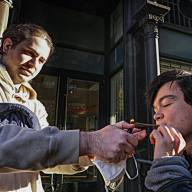Of all the senses used when driving, the most important is vision. “I didn’t see it” is the most common excuse for collisions, and of course, the problem becomes much worse at night.
While they’re not meant to substitute for safe driving practices — it’s dangerous to “overdrive your headlights,” driving too fast to react to objects as they appear in your lights — night vision systems can help detect dangers such as pedestrians, animals or road signs before they’re visible to the driver through the windshield.
Such systems are currently available from a few manufacturers, including Mercedes-Benz, which puts its Night View Assist on its E-Class, S-Class and CL-Class.
“The headlamps transmit two infrared beams, and there is an infrared sensor mounted to the top of the windshield,” says David Sherrard, product planner for Mercedes-Benz Canada.
“The camera picks up what the beams are sending back, and based on the distances and the images ahead of you, they’re recreated and displayed for you in the instrument cluster.”
On average, regular headlights illuminate the road ahead for about 50 metres, while high-beam headlights go about 106 metres. Sherrard says that Night View Assist can “see” ahead about 150 to 200 metres.
Automakers use two types of systems, both with pros and cons: active systems scan with infrared beams, while passive systems use special cameras to measure and display heat, known as thermal imaging. The active system, which Mercedes-Benz uses, has a slightly shorter forward range, but gives a clearer image and works better in warmer weather than passive.
Night View Assist broadcasts in a black-and-white screen in the instrument cluster.
The cluster contains an LCD display which shows an uncannily realistic round speedometer when the system is off, and changes to a speedometer bar below the screen when it’s on. Objects that might not immediately show up in the vehicle’s headlights are clearly visible on the screen.
“It’s supposed to be used the same way as your side or rearview mirrors,” Sherrard says. “It’s a quick reference, not a substitute for looking out the windscreen.
“Glancing down at it periodically, especially in circumstances where you’re not familiar with the road, gives you a momentary check to get better bearings of where you’re driving.
“No matter how sophisticated your headlamps, anything that can pick up pedestrians or animals can give you that additional advantage and extra few seconds to react in critical situations.”













